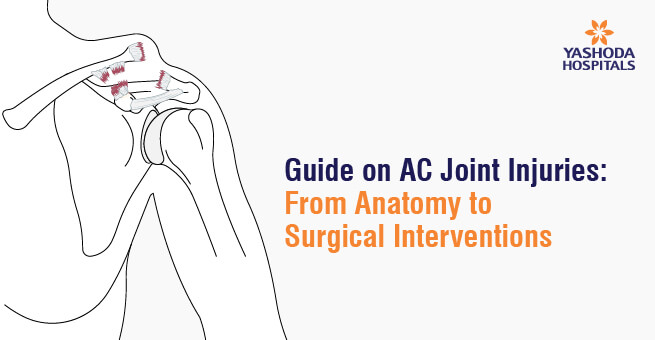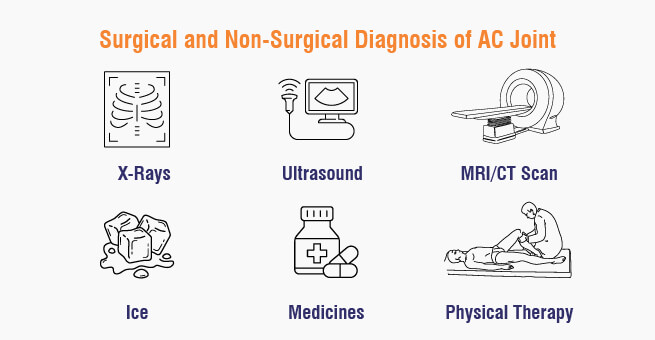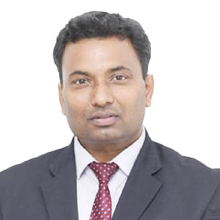Guide on AC Joint Injuries

Anatomy of AC joint and its Functions
The Acromioclavicular Joint or AC joint is a complex joint located at the top that connects the collarbone – lateral clavicle with the acromion process of the shoulder blade (scapula). This synovial gliding joint helps attach the scapula to the clavicle which in turn allows for free movement of the upper arm thus proper functioning. Other shoulder movements like elevation, depression, protraction, retraction and rotation; important for day-to-day tasks and sports activities. The AC joint is also stabilized by several ligaments, including the acromioclavicular and coracoclavicular ligaments.
The primary function of the AC Joint is:
- To allow the scapula additional range of rotation on the thorax.
- Allow for adjustments of the scapula (tipping and internal/external rotation) outside the initial plane of the scapula in order to follow the changing shape of the thorax as arm movement occurs.
- The joint allows the transmission of forces from the upper extremity to the clavicle.
Understanding Acromioclavicular Joint Injuries
Dislocations of the Acromioclavicular (AC) joint is frequent among athletes and during physical activities. Resulting of direct trauma to the shoulder, causing sports injuries, falls, accidents, and excessive stress, leading to the clavicle (collarbone) separating from the scapula (shoulder blade) at the joint.
Causes of Acromioclavicular Joint Dislocation:
- Sports Injuries: Strong-impact sports like football, rugby, and hockey can result in this type of injury more often.
- Falls: Falling directly on their shoulder can cause dislocation.
- Accidents: Major Car accidents or any other when given pressure, stress falls on the shoulder area which can cause dislocation leading to surgery.
- Repetitive Stress: More usage of the shoulder joint in activities like weightlifting can contribute to AC joint fracture injuries.
Symptoms of Acromioclavicular Joint Dislocation:
AC Joint Tear Symptoms
- Pain: Rigorous and severe pain at the top of the shoulder.
- Swelling: Swelling, warmth and gentle skin around the AC joint.
- Bruising: Visible rashes or redness may develop over the shoulder.
- Deformity: A bump or swelling of the shoulder, can indicate a displaced or dislocated clavicle.
- Less scale of Movement: Difficulty moving the shoulder, especially when lifting the arm.
AC Joint Separation Symptoms
- Pain: Rigorous pain at the AC joint.
- Weakness: Weakness in the shoulder, making it difficult in daily activities like to lift objects.
- Instability: Instability or looseness feeling in and around the dislocated shoulder.
- Clicking Sensation: Basically heartbeat sensation like clicking or popping when moving the shoulder.
Experiencing shoulder pain? Contact us for expert care and relief today!
Diagnosis and Treatment for Acromioclavicular Joint Injuries
Diagnosis of AC Joint Injuries
Clinical Evaluation includes the history inquiry about the pain mechanism, location, swelling, and past shoulder issues. Physical Examination such as deformity, sites that cause pain, and area of movement limitations. Special Tests are also conducted for complete examination like the Cross-Arm Adduction Test or O’Brien’s Test to examine pain at the AC joint.
Imaging Studies:
- AC Joint X-Rays: Provide initial assessment, focusing on certain views and bilateral comparison.
- Ultrasound: Useful for dynamic evaluation of soft tissue injuries.
- MRI/CT Scan: Offer detailed imaging for assessing ligaments, soft tissues, and associated injuries.
Non-Surgical Treatment:
- Rest: Avoid activities that stress the shoulder.
- Ice: Apply ice packs to reduce swelling and pain.
- Medicines: Painkillers like ibuprofen or acetaminophen can help ease severe pain.
- Physical Therapy: Exercises to strengthen the shoulder and improve movement.
Surgical Treatment:
Several surgical treatments are available for acromioclavicular (AC) joint injuries, depending on the severity and complexity of the individual:
- AC Joint Reconstruction: Repairs or reconstructs broken ligaments with the use of sutures, artificial grafts like allografts to repair joint complex and fix them to in right alignment
- AC Joint Stabilization: Techniques just like the Weaver-Dunn method stabilize the joint with the aid of casting off a portion of the distal clavicle and moving the coracoacromial ligament. Implants along with screws, suture anchors, or artificial ligaments may also be used.
- Arthroscopic Surgery: Minimally invasive approach where a small incision is made to remove the damaged tissues, broken bone spurs, and repair or reconstruct ligaments.
- Distal Clavicle Resection: Removes a part of the distal clavicle to reduce the continual pain or arthritis when non-surgical treatment fails.
- Latarjet Procedure: Transfers a portion of the coracoid process to the glenoid to stabilize the shoulder joint, most often used for recurrent shoulder instability.
These procedures aim to restore stability, relieve pain, and improve shoulder function, with the choice depending on the injury’s severity and patient-specific factors.
Healing Management & Recovery Time
Acromioclavicular joint dislocation varies in terms of time and recovery methods. The acromioclavicular joint injury is divided into six grades of severity of the of the acromioclavicular joint dislocation treatment:
- Grade I: Mild sprain without dislocation.
- Grade II: Partial dislocation and mild displacement.
- Grade III: Complete dislocation and displacement.
- Grades IV-VI: Severe dislocations with additional problems such as muscle tearing or clavicle displacement beyond the acromion.
Based on the dislocated AC joint recovery time depends on the severity of the injury and the type of treatment:
- Grade I (Mild): Typically ac joint pain heals within 1-2 weeks.
- Grade II (Moderate): Usually takes about 2-4 weeks.
- Grade III (Severe): May take 6-12 weeks, sometimes longer.
- Grades IV-VI (Very Severe): Mostly require surgical intervention, and recovery can take several months
AC joint injuries should be managed depending on how severe they are. Conservative treatments for mild to moderate cases usually include rest, ice, NSAIDs, and physical therapy. On the other hand, surgery may be necessary for severe injuries, especially in people with higher physical demands or when conservative treatment fails.
AC Joint Surgery Success Rate
The majority of studies indicate that AC joint dislocation treatment has positive outcomes in terms of pain relief, useful improvement, and person satisfaction. However, a number of other factors additionally affect the success rate, which includes the surgical methods, the intricacy of the dislocation, and the pre- and post-operative protocols. Although they may be unusual, complications and risk factors which include inflammation, infection, or insufficient ligament restoration.
Conclusion:
The acromioclavicular (AC) joint is more prone to accidents, specifically dislocations, it is essential for functions like movements. Depending on the severity, the analysis of basic imaging and a medical evaluation. Treatment options consist of non-surgical measures and surgical treatment. Recovery instances vary, however spark off care produces tremendous effects and lets in patients to head again to their each day’s sports with little hassle.
Overall, understanding the anatomy, function, causes, symptoms, diagnosis, and treatment options for AC joint injuries is important for healthcare experts and people alike to make certain positive outcomes and allow patients to return to their everyday activities with minimum long-term issues.
About Author –
Dr. Sunil Dachepalli, Consultant Orthopedic Joint replacement & Arthroscopic Surgeon, Yashoda Hospitals – Hyderabad
MS ( Ortho), MBBS, MRCS, CCBST, MSc (Tr & Ortho), MCH (Ortho), FRCS ( Tr & Ortho)









 Appointment
Appointment WhatsApp
WhatsApp Call
Call More
More

